
Feedback Management System: Importance, Tips & Tools
A Feedback Management System is integral to the growth of your business, providing a structured approach to collecting, organizing, and analyzing customer feedback.
Understanding the significance of this system is key; it empowers you to make data-driven decisions that enhance your products and services, ensuring they align with customer needs and expectations. To harness its full potential, familiarize yourself with actionable tips such as encouraging honest feedback, making the process easy for users, and responding promptly and thoughtfully to the input received.
Moreover, implementing the right tools – from simple survey platforms to complex analytics software – can streamline your feedback management process, turning customer opinions into valuable insights and actionable improvements.
What is a Feedback Management System?
A Feedback Management System (FMS) is a centralized platform designed to collect, organize, and analyze customer feedback. It crucially allows you to establish a feedback loop, ensuring that your customer feedback management (CFM) efforts lead to actionable insights and continuous product or service improvement.
Components of an Effective Feedback System
- Feedback Channels: These are the various ways feedback is collected, such as surveys, social media, or customer support interactions.
- Types of Feedback: This refers to classifying feedback into categories like suggestions, complaints, and questions to facilitate targeted responses.
- Multi-channel Feedback Collection: A robust system enables feedback collection across multiple channels for a holistic view of customer opinions.
- Centralized Platform: Consolidating feedback in one location simplifies feedback analysis and helps foster a strong feedback culture within your organization.
Enterprise Feedback Management vs. Customer Feedback Management
- Enterprise Feedback Management (EFM): Focused on obtaining feedback from multiple stakeholders, including employees and partners, EFM is often part of a larger strategic management initiative.
- Customer Feedback Management (CFM): Primarily targeted to gather and analyze customer-centric feedback to improve product or service.
Why Gather Customer Feedback?
Gathering customer feedback is essential to understand your market's needs and preferences, allowing you to make informed decisions. It helps to enhance the customer experience by showing that you value their opinions, which is a key part of building a lasting feedback program.
- Improving Products and Services: Customer feedback is essential for understanding the strengths and weaknesses of your products or services. It provides direct insight into customers' likes and dislikes, allowing businesses to make informed decisions about product development and improvements.
- Measuring Customer Satisfaction: Feedback helps companies measure customers' satisfaction with their products or services. Satisfaction levels are strong indicators of customer retention, loyalty, and product repurchase. Tracking these metrics over time can help predict business growth and identify areas that need attention.
- Enhancing Customer Experience: By collecting feedback, businesses can identify specific elements of the customer experience that are not meeting expectations. This enables companies to make targeted enhancements to customer service, user experience, and overall customer journey, increasing satisfaction and loyalty.
- Informed Decision Making: Customer feedback provides valuable data that can guide strategic decisions. It can highlight trends and preferences within your customer base, helping you to prioritize resource allocation, marketing strategies, and other business initiatives.
- Building Customer Relationships: Inviting feedback shows customers that their opinions are valued and that the company is committed to serving their needs. This can strengthen the customer-business relationship, fostering a sense of community and increasing customer engagement.
- Competitive Advantage: Businesses can stay ahead of the competition by continuously gathering and acting on customer feedback. Implementing changes and improvements based on customer suggestions can lead to a superior product or service offering, setting the company apart in the marketplace.
How to Build a Customer Feedback Management System?
Building a robust customer feedback management system is critical for understanding your customer journey, improving customer satisfaction, and driving product development. It allows you to capture, analyze, and act on customer insights to enhance the customer experience and foster brand loyalty.
Collect and Solicit Valuable Customer Insights via Multiple Channels
Begin by setting up multiple channels like surveys, user reviews, and direct feedback through customer support to gather diverse customer insights. Utilize every customer touchpoint, ensuring you capture feedback from as many sources as possible.
1. Surveys and Questionnaires
Use tools like SurveyMonkey, Google Forms, or Typeform to create and distribute online surveys to your customers via email, social media, or a pop-up on your website. Use a combination of multiple-choice and open-ended customer feedback questions for comprehensive feedback. Implement Net Promoter Score (NPS) surveys to gauge customer loyalty and identify potential customer churn.

2. Feedback Forms
Embed a feedback form on your website that is easily accessible to visitors. This can be a dedicated "Feedback" page or a simple form that pops up after a certain time or upon exit intent.
Integrate feedback forms directly within your software with feedback management systems. After certain actions or on particular screens, prompt users to provide feedback. Make sure these forms are not intrusive to the user experience.
3. Feedback Portals
Create a centralized place for product feedback to keep track of different types of customer feedback and improve SaaS products while listening to their customers. This is possible with Rapidr.
Rapidr helps SaaS companies be more customer-centric by consolidating feedback across different apps, prioritizing requests, having a discourse with customers, and closing the feedback loop.
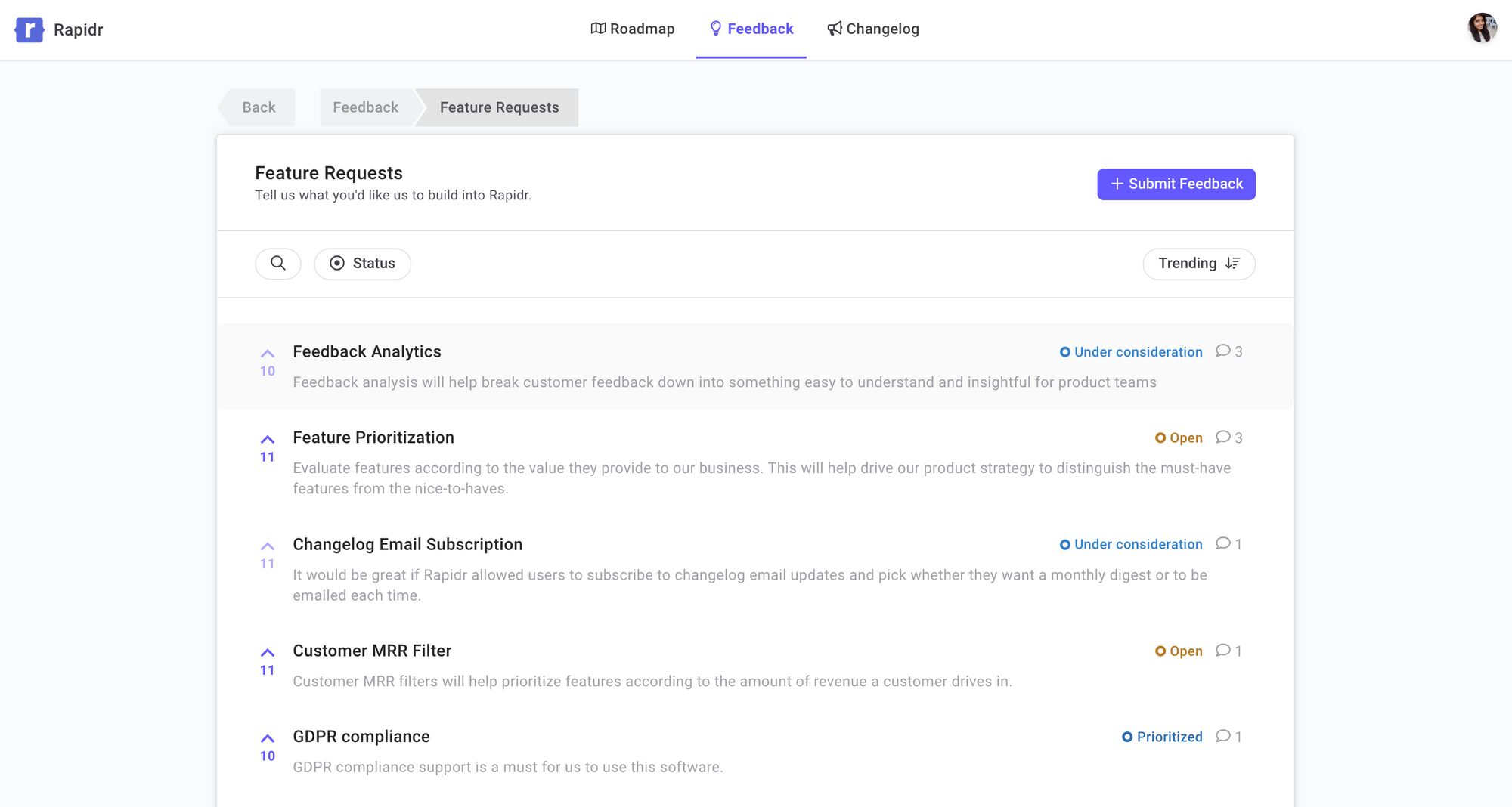
4. Email Campaigns
Send personalized email campaigns to customers post-purchase or after service delivery asking them to provide feedback on their experience. Include a clear call-to-action (CTA) and a direct link to a feedback form or survey.
5. In-app Feedback
Utilize in-app feedback platforms to ask users about their experiences in real time. This can be done through chatbots or pop-up messages, prompting immediate feedback while the user is engaged with the product.
Rapidr's deep Intercom Integration makes it easy for your product and customer success teams to track incoming feedback on Intercom.

6. Customer Interviews and Focus Groups
Conduct one-on-one interviews with customers in person or via video conferencing to gain in-depth insights. Organize focus groups with a selection of customers to discuss their experiences and opinions about your products or services.
7. Usability Tests
Collect beta testing feedback by asking a group of customers to test new features of your product. You can do this through various platforms by organizing beta-testing groups among your customers.
8. Customer Support
Your customer support team often interacts directly with customers, hearing their pain points and praises first-hand. Ensure an internal team feedback system is set up for this valuable information to be collected from customer-facing teams and shared with the product team.
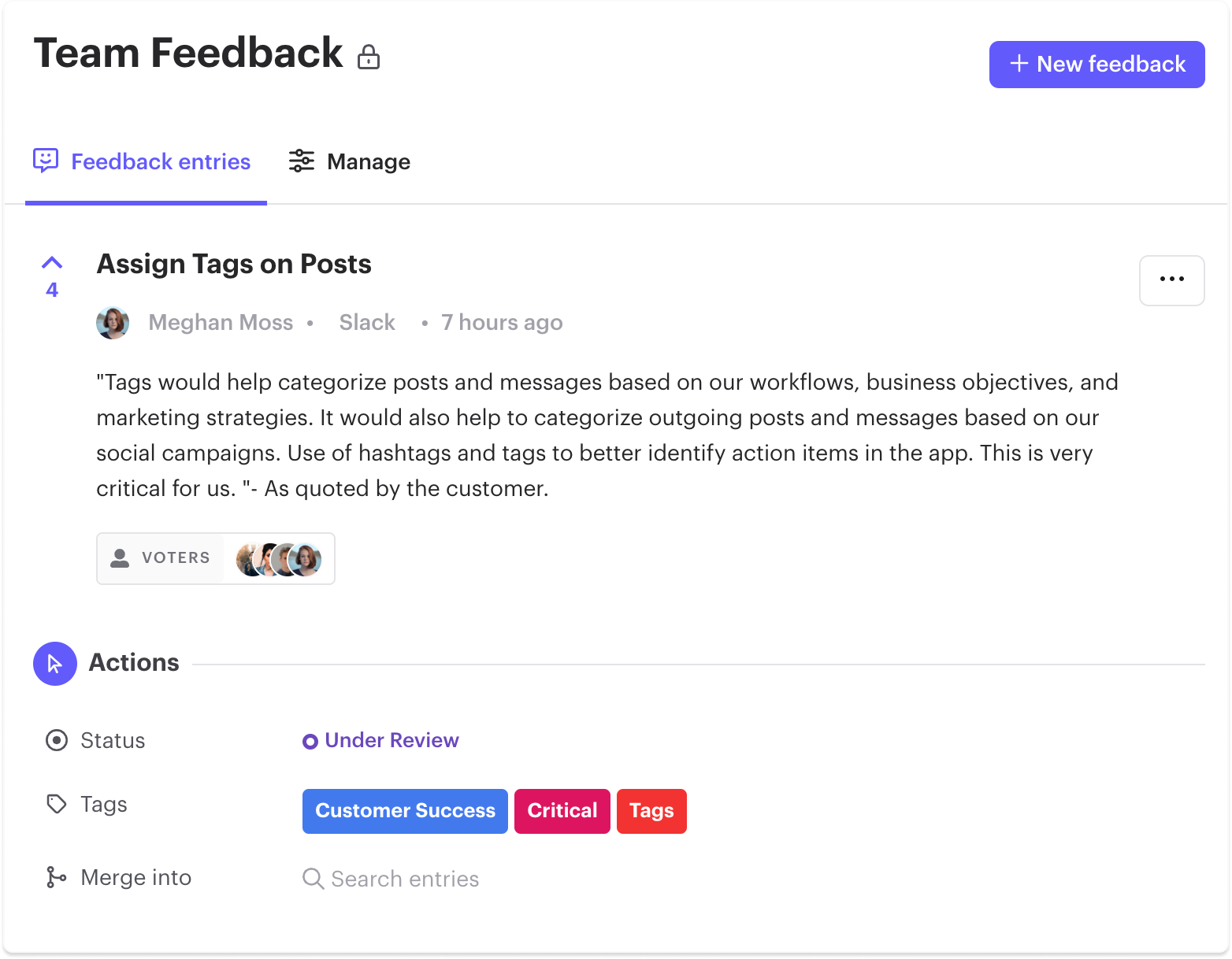
9. Social Media
- Direct Engagement: Post questions or polls on platforms like Facebook, Twitter, or Instagram to engage your audience and solicit feedback.
- Social Listening: Monitor mentions, hashtags, and direct messages to gather unsolicited feedback and respond to it.
When asking for customer feedback, it's important to make the process as easy and convenient as possible for the customer. Be clear about how their feedback will be used to improve their experience, and always thank them for their time and insights. Additionally, it's crucial for businesses to act on the feedback received to demonstrate to customers that their opinions are valued and taken seriously.
Analyze and Prioritize Customer Feedback Data
Once collected, centralize your feedback data in a single system. This can involve using specialized software tools that enable you to filter, sort, and analyze the feedback for actionable insights. Centralization makes it easier to recognize trends and patterns in customer feedback that are critical for driving strategic decisions.
Categorize feedback into themes like usability, pricing, or service quality. Use filters to organize the feedback by demographic, product, or service line. Then, sort by date, urgency, or impact potential. Analyzing your collected data helps identify key areas for improvement and informs prioritization in product development processes. Aligning feedback with business goals to determine priority and cost of delay can ensure that product decisions are informed by customer needs.
Analyzing user feedback data can provide valuable insights that drive product development and improvement. Businesses need mechanisms to collect feedback through various channels, such as online reviews, surveys, and community feedback forums. Once collected, data analytics and product research tools can be used to analyze this feedback to identify patterns, trends, and areas for improvement.
- Start by revisiting the collected feedback and research insights. Organize them systematically, focusing on the key findings that align with your product's vision and goals.
- Perform ideation to seek the most effective solution. All feedback is valuable, but not all feedback needs immediate action. Classify insights based on urgency, feasibility, and alignment with business goals.
- For qualitative data, identify patterns, themes, and notable quotes.
- Use user segments and statistical methods to interpret results and find correlations and conclusions for quantitative data.
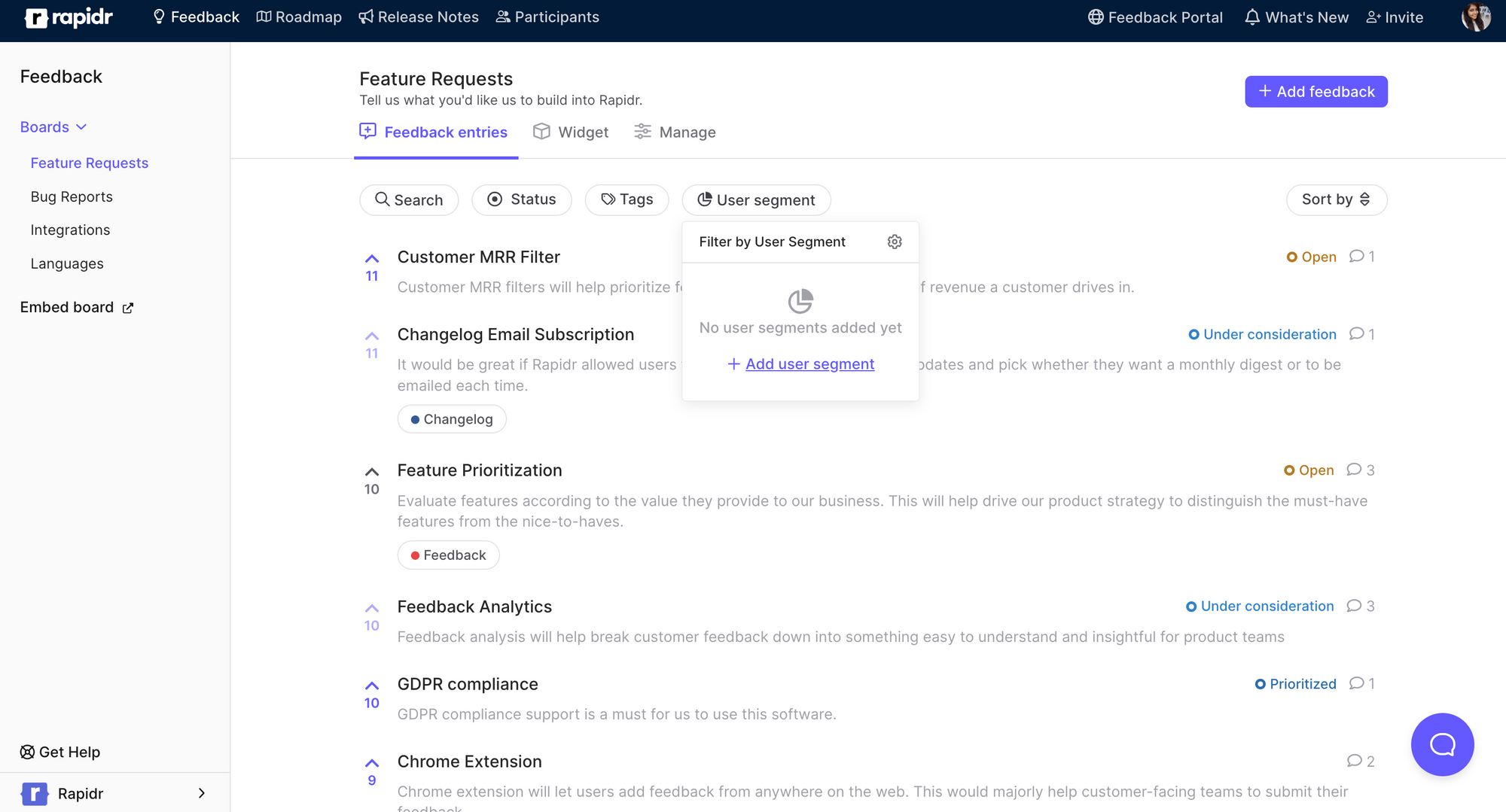
Acknowledge The User Feedback & Navigate Negative Feedback and Complaints
All feedback is valuable, including negative feedback and complaints. Acknowledge all feedback promptly, ensuring customers feel heard and valued. Responding to negative feedback can turn unhappy customers into loyal advocates and often provides the most insightful opportunities for improvement.
It's impossible to say yes to all ideas, but the right ones can help guide your product roadmap. It is equally important to respond to negative feedback as it is to collect feedback in the first place. Managing customer complaints effectively can reduce churn and turn detractors into promoters.
Share your findings with team members, executives, and other stakeholders to drive decision-making. This step is crucial for maintaining healthy customer relationships and demonstrating that you value their input.
Act-On Customer Feedback to Improve Customer Satisfaction
Develop a plan to implement changes based on the feedback. Align these improvements with your product development and customer experience strategies to ensure they will effectively improve customer satisfaction and customer retention. Monitor the impact of changes on the customer experience and refine as needed.
Integrate customer feedback into your product development process. Regularly update your product roadmap to reflect changes inspired by feedback. Implement changes that align with your business goals and will have a high impact on customer satisfaction. Ensure your customer success teams are involved in the feedback loop to foster customer loyalty and retention.
Listen to the voice of the customers through various channels like email, social media, website feedback, and chatbots. Ask for feedback and respond proactively to their queries and complaints to increase customer loyalty and satisfaction. Keep them in the loop about which requests are in progress or planned and which are done with a public roadmap offered by Rapidr.
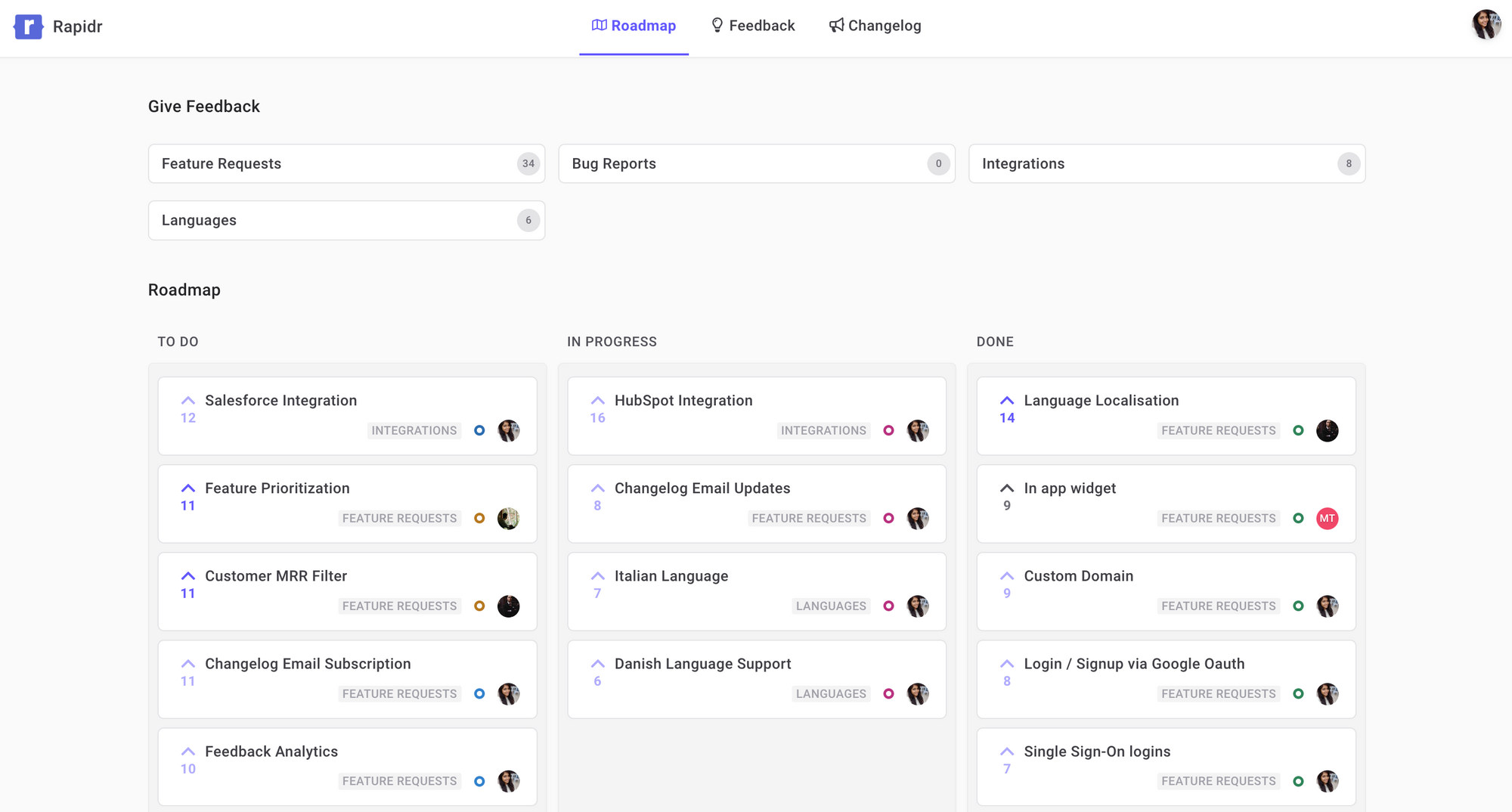
Follow Up & Update Customers on Changes and New Features
After acting on the feedback, close the loop by updating your customers about changes or new features introduced. Regular follow-ups demonstrate your commitment to their satisfaction and can positively influence retention and NPS scores.
Closing the feedback loop includes informing customers about the actions you've taken. This may involve:
- Updating them on new features and improvements.
- Sharing roadmap changes via newsletters or in-app messages.
- Highlighting how feedback has influenced product evolution.
When you release new features or updates, reach out to users to see how they find them. Clear communication is vital to cohesive development, even if it means saying no to some feature requests. Following up shows that you act on customer feedback, strengthening loyalty and ensuring your company remains customer-centric.

By diligently collecting, analyzing, and acting on customer feedback, you can refine your product, enhance the customer experience, and solidify customer loyalty, which is essential in today's competitive market.
How to Choose the Right Feedback Management Tool?
When looking for a feedback management tool, it's crucial to consider your specific needs. Carefully weigh these considerations against your business needs to choose the most suitable feedback management tool. Here's a structured approach to making a confident choice:
- Identify Your Goals: What do you want to achieve with the feedback? Whether improving product development or understanding customer satisfaction, your goals will guide your choice.
- Assess Integration Capabilities: The tool should easily integrate with your existing systems, like CRM software or help desks, to streamline processes.
- Consider the Feedback Channels: Opt for a tool that accommodates various channels such as surveys, emails, and social media to garner a broad range of insights.
- Analyze the Features: Essential features might include collecting, analyzing, and acting on feedback. Look for user-friendly interfaces and robust analytics capabilities.
- Review the Scalability: Ensure the tool can grow with your business and handle increasing amounts of feedback over time.
- Check for Customization: You should be able to customize the tool to fit your branding and specific feedback strategies.
- Evaluate Support and Resources: A good tool comes with reliable customer support and a wealth of resources to help you get the most out of the software.
Best Feedback Management Software & Tools of 2024
1. Rapidr
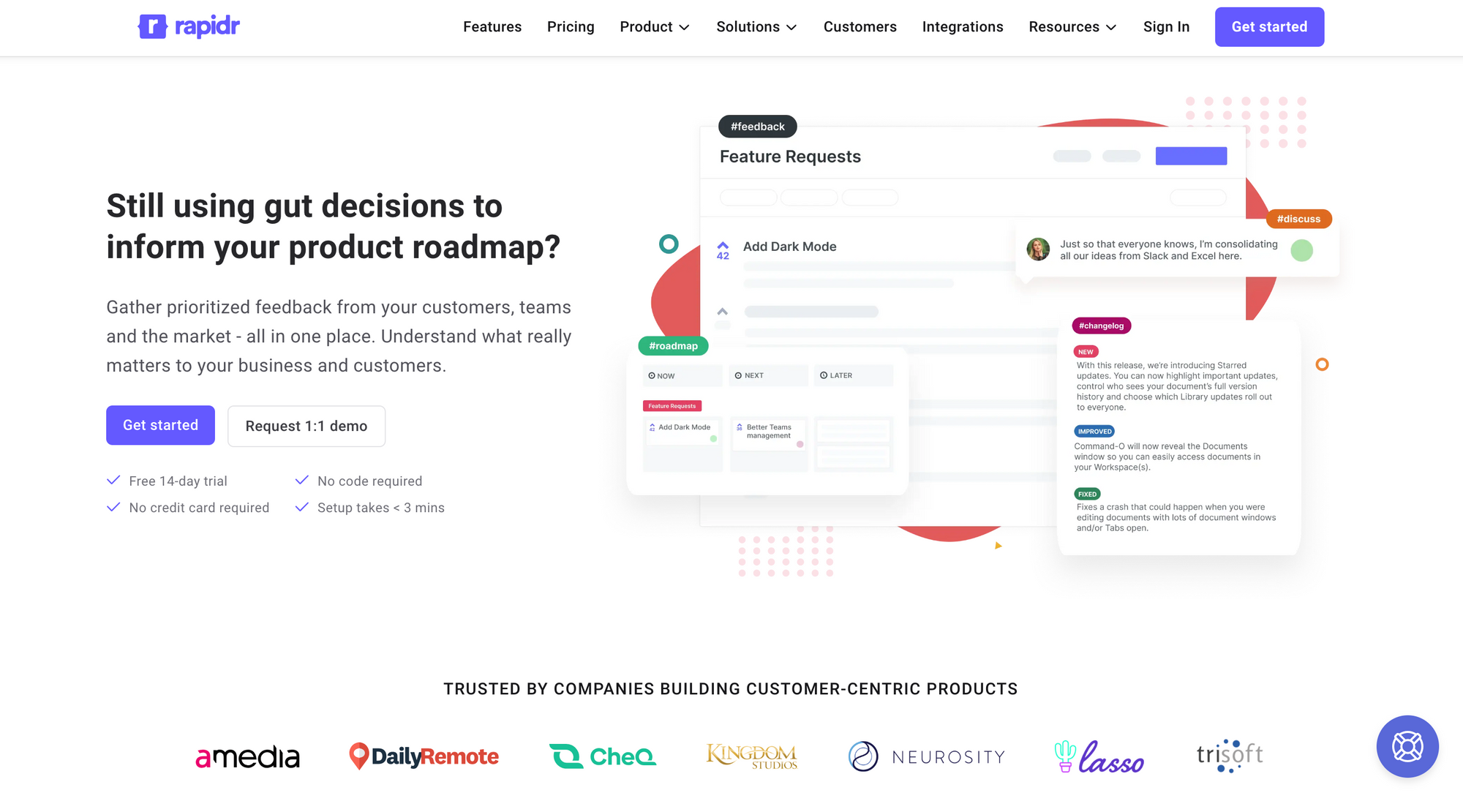
Rapidr is an enterprise feedback management software and feature tracking tool that helps manage the entire feedback lifecycle, from capturing feature requests to prioritizing features, informing product roadmap, and sharing product updates with changelog.
Rapidr allows you to capture and track all user feedback and organize and analyze them under one roof in a centralized location. Then, inform your roadmap with the most critical feedback, and notify users of what's new with release notes.
Pricing: Starts at $49/month.
Features of Rapidr
- Rapidr is an end-to-end customer feedback management solution, so you don't have to glue multiple apps together. With it, you get a customer feedback management tool, feature request collection software, road mapping software, and release notes software.
- Rapidr is one of the most modern and cost-effective solutions whose pricing is based on the weight you derive from the software instead of per-seat pricing.
- Rapidr can be fully white-labeled on high-end plans, which means no visible branding and is built to support varying workflows and to be customizable from day one.
- Rapidr supports major integrations such as HubSpot, Jira, Intercom, Slack, SAML SSO, etc., and many more at the time of writing to collect and manage customer feedback.
- Rapidr is relatively new in the market, and many features are still being built and tracked on their public feedback board.
2. UserVoice
UserVoice caters to companies that want to gather customer feedback, process support requests, and increase customer satisfaction. UserVoice allows companies to create feature request voting boards for customers to share their ideas, opinions, and votes.
Features of UserVoice
- UserVoice creates a feedback loop by providing feedback forum software enabled with roadmap functionality.
- UserVoice has streamlined communication with customer-facing and product teams and keeps all product feedback in one location to increase transparency.
- UserVoice has an outdated user interface. It’s hard to navigate and has a steep learning curve compared to its alternatives.
3. SurveyMonkey
SurveyMonkey is an all-in-one survey tool that helps run customer satisfaction surveys(CSAT) and NPS to get product feedback and ask customer feedback questions to users. It also supports employee engagement surveys to understand employee satisfaction within the company.
Features of SurveyMonkey
- SurveyMonkey offers advanced reporting and data analysis capabilities as well.
- Limited customization options for some of the survey templates. It also does not provide public product roadmaps and changelog functionality like Rapidr.
- Higher pricing for advanced features, such as skip logic and data export, doesn't support different types of customer feedback.
4. Mopinion
Mopinion empowers its users to create customizable online feedback forms, including various CX metrics such as NPS, CES, and CSAT, and trigger them based on rules such as mouse movement, exit intent, and much more.
It also includes visualization in customizable dashboards and text analysis and labels. Users can use proactive alerts and role-based views to act upon feedback.
Features of Mopinion
- It allows you to create, design, and configure feedback forms and embed them directly into the site.
- Mopinion also helps you collect and organize different types of customer feedback across multiple channels. Logic to control who sees the forms.
- You can also target these feedback forms to specific groups of online visitors, get insights into why they are not converting, and capture additional user data.
5. Feedier
Feedier is a new innovative platform for collecting valuable feedback. It helps turn feedback into growth leverage by making data-driven decisions to improve your services and products.
Features of Feedier
- It provides branded surveys and in-site widgets that allow customers to give feedback without leaving the website.
- It also supports a built-in reporting dashboard and follow-up emails on survey incentive management.
- Apart from surveys, it also allows users to receive ratings, testimonials, and social media engagement to improve customer relationships.
Rapidr: The Best Customer Feedback Management Software Tool For You
One of the most common questions businesses ask is which product feedback tool is right for them. The answer to this question depends on several factors, such as the size and budget of the company, customer base, and customer feedback needs.
While many customer feedback management tools help you capture, organize, and prioritize feedback, consider the one that enables you to uncover the insights from the feedback and shape your product strategy.
1. Centralized and organized by category: The first step in solving this is to organize feedback in a central location. You’ll likely receive feedback from various channels and integrations like emails, Slack channels, support inboxes, forms, and in-app widgets.
2. Easily accessible to everyone: Centralizing all feedback data in one place, which can be easily accessed, will ensure that critical feedback doesn’t get lost and will allow you to understand what to prioritize.
3. Shared across internal teams: A central hub lets customer-facing teams access and submit feedback easily. A dedicated system will also help plan regular meetups with teams to discuss customer feedback and determine how to use it to define product strategy.
4. Prioritize and analyze feedback: Prioritize features and rank feature requests and tasks based on impact to make feedback-driven decisions. Remember, it's not just about collecting feedback. The real power lies in analyzing this qualitative data and implementing actionable changes that genuinely reflect your customers' desires and pain points. This ongoing listening, learning, and improving cycle sets successful companies apart.
With Rapidr, you can collect, analyze, and organize feedback and engage with customers as their feedback moves through the development process. Other notable features include collecting feedback via widgets, slicing and dicing feedback, embedding a roadmap into your product, and closing the feedback loop.
Sign up and set up a complete customer feedback management system to boost customer retention and satisfaction.

